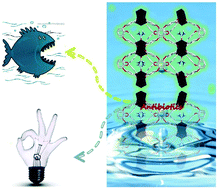A bifunctional 3D Tb-based metal–organic framework for sensing and removal of antibiotics in aqueous medium†
Abstract
A bifunctional Tb-based metal–organic framework, namely {[Tb(TCPB)(DMF)]·dioxane·0.5H2O}n, has been assembled from the tripodal ligand 1,3,5-tris(4-carbonylphenyloxy)benzene (H3TCPB) using solvothermal methods and characterized by EA, TG, IR, PXRD, etc. Structural analysis revealed that Tb-MOF is a 3D (4,8)-c net with the point symbol {44·62}2{48·617·83} and contains two different 1D channels, rectangular (11.115 Å × 13.231 Å) and quadrilateral (12.228 Å × 19.210 Å). The luminescence properties of Tb-MOF showed that it has high sensitivity to and exhibits selective sensing for nitrofurazone (NZF) and nitrofurantoin (NFT) in aqueous solutions. Meanwhile, owing to its typical Tb yellowish-green emission, the ground Tb-MOF powder can be used for fingerprint recognition. Furthermore, because of its pores and surface area, the adsorption capacity of Tb-MOF for NFT and NZF in water medium can reach 81.3% and 84.4% within 120 min, respectively. The title compound is the first bifunctional material for the detection and removal of antibiotics in water systems at the same time.



 Please wait while we load your content...
Please wait while we load your content...